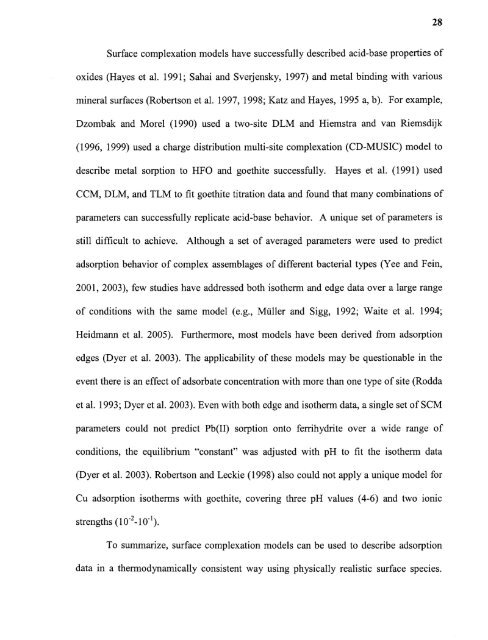Heavy metal adsorption on iron oxide and iron oxide-coated silica ...
Heavy metal adsorption on iron oxide and iron oxide-coated silica ...
Heavy metal adsorption on iron oxide and iron oxide-coated silica ...
Create successful ePaper yourself
Turn your PDF publications into a flip-book with our unique Google optimized e-Paper software.
28Surface complexati<strong>on</strong> models have successfully described acid-base properties of<strong>oxide</strong>s (Hayes et al. 1991; Sahai <strong>and</strong> Sverjensky, 1997) <strong>and</strong> <str<strong>on</strong>g>metal</str<strong>on</strong>g> binding with variousmineral surfaces (Roberts<strong>on</strong> et al. 1997, 1998; Katz <strong>and</strong> Hayes, 1995 a, b). For example,Dzombak <strong>and</strong> Morel (1990) used a two-site DLM <strong>and</strong> Hiemstra <strong>and</strong> van Riemsdijk(1996, 1999) used a charge distributi<strong>on</strong> multi-site complexati<strong>on</strong> (CD-MUSIC) model todescribe <str<strong>on</strong>g>metal</str<strong>on</strong>g> sorpti<strong>on</strong> to HFO <strong>and</strong> goethite successfully. Hayes et al. (1991) usedCCM, DLM, <strong>and</strong> TLM to fit goethite titrati<strong>on</strong> data <strong>and</strong> found that many combinati<strong>on</strong>s ofparameters can successfully replicate acid-base behavior. A unique set of parameters isstill difficult to achieve. Although a set of averaged parameters were used to predict<str<strong>on</strong>g>adsorpti<strong>on</strong></str<strong>on</strong>g> behavior of complex assemblages of different bacterial types (Yee <strong>and</strong> Fein,2001, 2003), few studies have addressed both isotherm <strong>and</strong> edge data over a large rangeof c<strong>on</strong>diti<strong>on</strong>s with the same model (e.g., Müller <strong>and</strong> Sigg, 1992; Waite et al. 1994;Heidmann et al. 2005). Furthermore, most models have been derived from <str<strong>on</strong>g>adsorpti<strong>on</strong></str<strong>on</strong>g>edges (Dyer et al. 2003). The applicability of these models may be questi<strong>on</strong>able in theevent there is an effect of adsorbate c<strong>on</strong>centrati<strong>on</strong> with more than <strong>on</strong>e type of site (Roddaet al. 1993; Dyer et al. 2003). Even with both edge <strong>and</strong> isotherm data, a single set of SCMparameters could not predict Pb(II) sorpti<strong>on</strong> <strong>on</strong>to ferrihydrite over a wide range ofc<strong>on</strong>diti<strong>on</strong>s, the equilibrium "c<strong>on</strong>stant" was adjusted with pH to fit the isotherm data(Dyer et al. 2003). Roberts<strong>on</strong> <strong>and</strong> Leckie (1998) also could not apply a unique model forCu <str<strong>on</strong>g>adsorpti<strong>on</strong></str<strong>on</strong>g> isotherms with goethite, covering three pH values (4-6) <strong>and</strong> two i<strong>on</strong>icstrengths (10 -2-10 1 ).To summarize, surface complexati<strong>on</strong> models can be used to describe <str<strong>on</strong>g>adsorpti<strong>on</strong></str<strong>on</strong>g>data in a thermodynamically c<strong>on</strong>sistent way using physically realistic surface species.
















